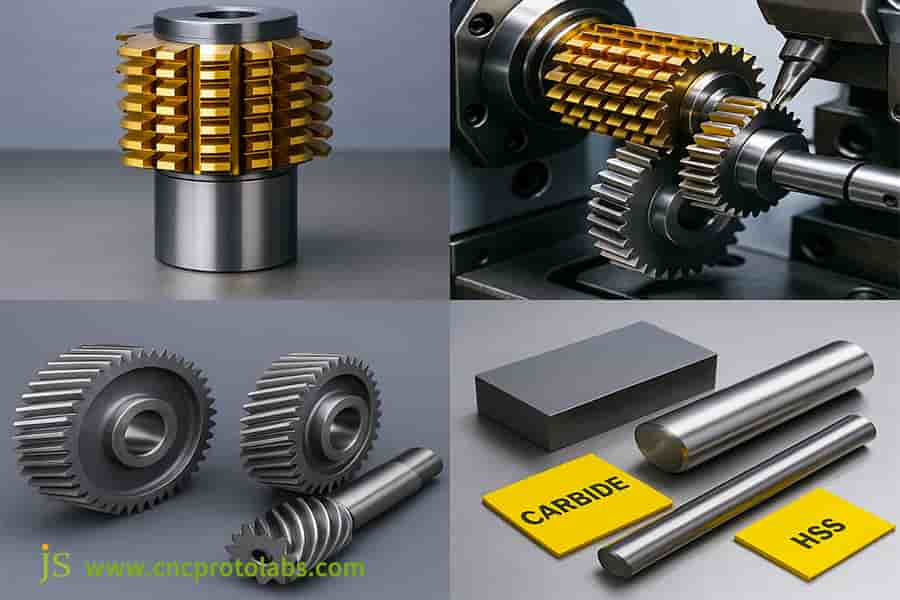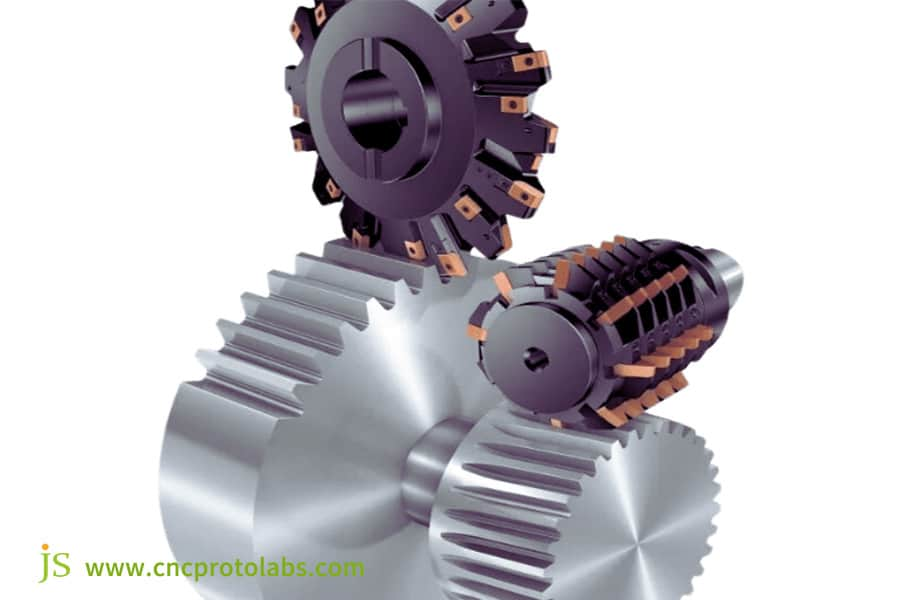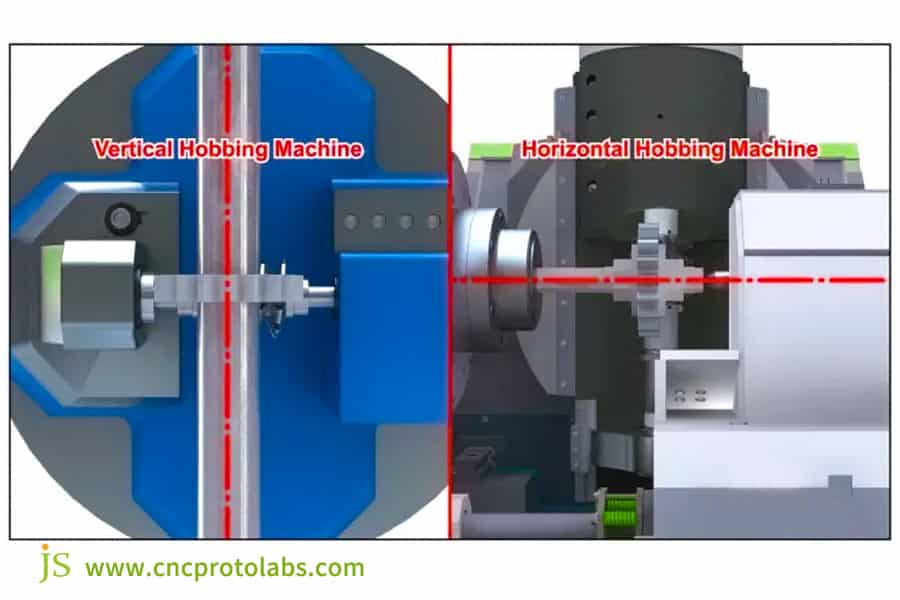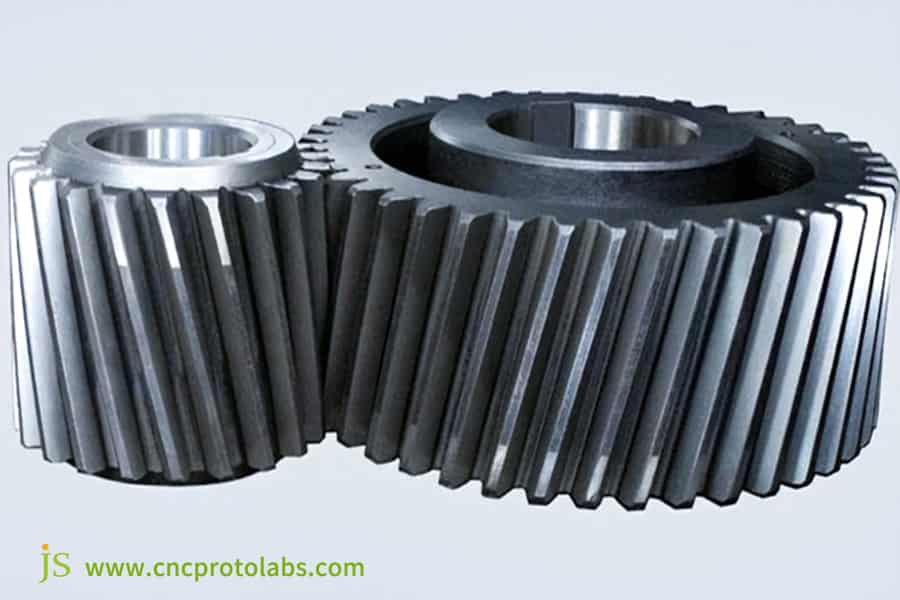|
Assessing Dimensions
|
Economical/Manual Gear Hobbing Machines
|
Standard CNC Gear Hobbing Machines
|
High-End/Five-Axis Gear Hobbing Machines
|
|
Core Applications
|
Repair workshop, single piece, low precision gear.
|
Small- to medium-volume, standard-precision gear processing.
|
Large-volume, worm gears, helical gears, complex tooth profiles.
|
|
Degree of Automation
|
Entirely operator skill dependent, low efficiency.
|
Partially automatic cycles with reduced operator dependence.
|
Complete automation, robot integration is possible, enabling unmanned manufacturing.
|
|
Precision Grade
|
Low (e.g., DIN Grades 10-11).
|
Standard (e.g., DIN Grades 7-9).
|
High-precision (e.g., DIN Grades 5-6 or higher).
|
|
Skill Requirements
|
Seasoned technician required.
|
Programming and operating skills required.
|
High-level programming and process skills required.
|
|
Investment Cost
|
Low
|
Medium
|
High
|
|
Value of JS Precision Partnership
|
Suitable for very basic, one-time needs.
|
Cost-effective solution, suitable for the majority of needs.
|
Optimum solution for complicated, high-accuracy gears.
|
Why Reliable? The Complete Guide To JS Precision Gear Hobbing Machine Selection
If you need custom gear machining services, JS Precision can match you with a solution based on our extensive experience. Just send us your gear drawing, and we'll promptly review and quote, enabling you to begin your gear hobbing project with ease. Selecting custom gear machining manufacturing is a hassle-free process.
Unveil The Secrets Of Gear Hobbing And Hobbing Process
The Fundamentals of a Gear Hob
Gear Hobbing Motion Breakdown
- Principal motion: Hob rotation to produce the cutting force.
- Sub-tooth motion: There exists a constant speed relationship between workpiece and hob (the hob rotates K/Z times for one revolution of the workpiece, where K is the number of hob heads and Z is the number of workpiece teeth). It directly affects the accuracy of tooth number.
- Axial feed: The hob is fed axially along the workpiece and the whole tooth width is machined. Machining efficiency and surface finish are a function of feed rate.
- Radial feed: Controls the depth of cut, which needs to be progressively adjusted based on gear module and material hardness to avoid excessive cutting force that can break the tool or workpiece.
Trends in CNC Gear Hobbing Machines
JS Precision also provides a series of high-precision CNC gear hobbing machines to satisfy the machining needs from spur to helical gears. Just provide us with your gear precision, material, and other requirements, and we will develop a customized gear hobbing process plan for you. After placing an order, we will arrange production and ship the gear machining parts in time.

Decision Starting Point: How To Determine The Type Of Gear Hobbing Machine According To Your Production Needs?
Type of Gear and Quantity
|
Gear Type/Batch Size
|
Appropriate Hobbing Machine Type
|
Core Reason
|
|
Cylindrical Spur/Helical Gears
|
General-purpose hobbing machine.
|
General application range, simple to use for most conventional gears.
|
|
Small-module gears (module < 1)
|
Small-module precision hobbing machine.
|
Greater accuracy, maintains tooth form errors in check for small-module gears.
|
|
High-volume production (quantity per day > 500 pieces)
|
High-efficiency hobbing machine with automated loader and unloader.
|
Saves manhandling, increases efficiency, and reduces unit cost.
|
Accuracy Requirements
Material and Hardness
Buying Checklist: 7 Factors To Consider While Buying A Gear Hobbing Machine
- Long-term technical support: Can the supplier provide timely technical support, training, and spare parts? Whether a 48-hour response time is available in the event of a machine failure directly impacts production.
- Thermal and stiffness of the machine: Is the machine bed welded steel or cast iron? What is the guideway? Is a cooling system used in the spindle? These all influence accuracy retention under heavy cutting over long time periods.
- CNC system and software: How user-friendly is the system? Does it support complex hobbing process cycles and 3D simulation for collision avoidance? An effective system can reduce programming time and reduce the risk of tool collisions.
- Space and energy consumption: Calculate the electrical load of the shop (e.g., whether the power supply for the hobbing machine is adequate) and space (if the size of the equipment is appropriate for the design) to avoid installation issues.
- Future-proofing: Is the equipment equipped with automated interfaces (e.g., robot loading/unloading)? Can it be made with additional features (e.g., online inspection)?
- Training expenses for operators: What investment and time are required to train proficient operators/programmers? Multitasking adds man-hours.
- Residual value: Well-known brands retain their value. For example, JS Precision partner brands command a 15%-20% higher secondhand price compared to lesser known brands.
As you purchase a gear hobbing machine, JS Precision is there to offer professional testing services to help you go through important specs such as technical support and machine rigidity. If you choose our custom rapid prototyping manufacturing service, you can also bypass purchasing the machine and receive qualified gear machining parts directly.
Parameter Deep Dive: Important Specifications For Choosing A Gear Hobbing Machine
- Maximum Processing Diameter and Module: They are the "limits" of the machine and the size of gear that it can process. For example, a 1-meter diameter machine will not cut a 1.2-meter gear. Maintain a 10%-15% safety margin to assist in overcoming workpiece tolerance issues.
- Torque and Spindle Speed: Precision machining of small modules is suitable at high speeds (e.g., >3000 rpm), roughness is increased, heavy cutting of modules >5 is sustained by high torque (e.g., >500 N·m) and avoids spindle stalling.
- Axial/Radial Travel: Axial travel determines the maximum tooth width (e.g., 300mm travel allows a 280mm tooth width), radial travel determines the outer diameter maximum and must be equal to the maximum machining diameter.
- Positional Accuracy and Repeatability: The accuracy of the positioning is related to the cumulative error on tooth pitch, and the repeatability affects batch consistency. CNC gear hobbing machines will generally possess positional accuracy of ≤0.005mm and repeatability of ≤0.002mm.
- Toolholder Interface and Specifications: Toolholder specifications (20mm, 32mm diameter) determine the size of the hob that can be fitted. The interface of the toolholder (e.g., HSK, BT) must be precisely matched, otherwise, the hob cannot be mounted.
JS Precision's gear hobbing machines boast a wide range of key specifications, and they can machine gears with 0.1 to 2.5 meters in diameter and 0.1 to 20 in module. Simply provide us with your gear size, and we will immediately match you with the appropriate equipment so that your gear machining parts are machined smoothly. Delivery is made within 7-15 days.

Accuracy Decoding: How To Understand The Accuracy Grade Of a Gear Hobbing Machine?
Standard System
|
Precision Grade (DIN)
|
Pitch Cumulative Error (mm)
|
Applicable Gear Applications
|
|
Grade 5
|
≤0.008
|
Precision transmission gears (e.g., aircraft gears).
|
|
Grade 6
|
≤0.012
|
Automotive transmission gears, wind turbine gears.
|
|
Grade 7
|
≤0.018
|
Industrial reducer gears.
|
|
Grade 8
|
≤0.025
|
Agricultural machine gears, general transmission gears.
|
Important Inspection Items
- Workpiece spindle accuracy: It includes end runout (≤0.002mm) and radial runout (≤0.001mm), which affect gear radial runout.
- Axial feed screw accuracy: The tolerance should be ≤0.003mm/100mm, otherwise, tooth profile errors can occur.
- Worktable indexing accuracy: The index error should be ≤0.005mm in order to enable precise workpiece rotation (extremely critical in traditional machine tools).
JS Precision CNC gear hobbing machines can accept DIN grades 5-8, so we can match your most appropriate precision grade for your gear application. You don't have to shell out money for more precision than you require with our service, and your gear machining parts will be made to your specifications. Submit your inquiry and receive the correct precision matching solution.
Vertical Vs. Horizontal Gear Hobbing Machine: Which One To Select?
|
Comparison Dimensions
|
Vertical Gear Hobbing Machine
|
Horizontal Gear Hobbing Machine
|
|
Advantages
|
Simple chip removal, easy to observe machining process, small footprint.
|
Firm workpiece support, and simple clampability for long shaft gears.
|
|
Disadvantages
|
Workpiece sagging due to gravity while clamping and thus not able to process long shafts.
|
Chip removal requires a supporting system and involves a large footprint requirement.
|
|
Useful Applications
|
Disc gears, ring gears (such as flange gears).
|
Long shaft gears (such as automotive axle gears and motor shaft gears).
|

Case Study: How JS Precision Surmounted The Challenges Of Large Helical Gear Machining For A Wind Turbine Gearbox Supplier
Customer Pain Points
JS Precision Solution
- Process Simulations and Optimization: Factory software modelled the cutting speed (80m/min), feed rate (0.2mm/r), and cutting depth (three times, 4mm each), simulating deformation and optimizing the fixture with workpiece support points to minimize deformation.
- State-of-the-Art Machinery: We utilized JS Precision's ultra-large 5-axis CNC gear hobbing machine with vibration reduction (reducing the machining vibration and improving roughness) and thermal error compensation (real-time temperature error compensation), completely satisfying the requirement of machining.
- Total Process Checking and Inspecting: Machining incorporates on-line real-time inspection via pitch and tooth profile deviation checks for the purpose of timely correction. Machining also performs total dimensional inspecting on a gigantic coordinate measuring machine to ensure the gears DIN Grade 6 accuracy.
Comparison of Final Outcome
- Cost: Rather than investing $1.5 million in equipment, they invested only in custom machining and saved more than 85% of initial capital outlay.
- Efficiency: The enhanced gear hobbing process shortened the processing time per unit from 72 hours to 48 hours, resulting in a four-month prior delivery compared to in-house capacity, enabling the client to place the order on time.
- Quality: Machine gear total pitch error was ≤0.012mm, and tooth form error was ≤0.008mm with DIN Grade 6 accuracy. And then the customer signed the three-year-long-term cooperation agreement.

It's Not Hardware: Why JS Precision Is Your Smarter "Gear Manufacturing Department"
- No Upfront Capital Needed: You enjoy good gear machining capacity without paying the high gear hobbing machine price, machine maintenance expense (estimated at 5% of machine value each year), or talent bottleneck (experienced operators cost 8,000-12,000 yuan monthly).
- Technical Know-how and Process: Not just the machine, technical know-how needed in optimizing gear hobbing process is our area of expertise. Based on material, we can select right tooling (carbide/high-speed steel), machining parameters (cutting speed/feed) and heat treatment processes so as to achieve maximum life and efficiency of the gear.
- Full-Process Quality Assurance: From raw material purchasing (e.g., partnership with world-class quality steel mills) to product finishing inspection, we provide complete dimension reports (pitch, tooth profile, and tooth guide deviations) to guarantee that all gear machining parts are imperfection-free.
- Height of Supply Chain Efficiency: We are in the position to deliver your needs in good time as your competent custom gear machining manufacturing company partner—standard gears in 7-15 days, and emergency orders in 3-5 days, cutting your time to market.
FAQs
Q1: What are the differences between gear hobbing, gear shaping, and gear milling?
Q2: Is it hard to run a CNC gear hobbing machine? Does it require any special training or skill?
Q3: What gear materials can you machine?
Q4: How do I obtain a quotation for gear machining?
Summary
Disclaimer
The contents of this page are for informational purposes only.JS Precision Services,there are no representations or warranties, express or implied, as to the accuracy, completeness or validity of the information. It should not be inferred that a third-party supplier or manufacturer will provide performance parameters, geometric tolerances, specific design characteristics, material quality and type or workmanship through the JS Precision Network. It's the buyer's responsibility Require parts quotation Identify specific requirements for these sections.Please contact us for more information.
JS Precision Team
JS Precision is an industry-leading company, focus on custom manufacturing solutions. We have over 20 years of experience with over 5,000 customers, and we focus on high precisionCNC machining,Sheet metal manufacturing,3D printing,Injection molding,Metal stamping,and other one-stop manufacturing services.
Our factory is equipped with over 100 state-of-the-art 5-axis machining centers, ISO 9001:2015 certified. We provide fast, efficient and high-quality manufacturing solutions to customers in more than 150 countries around the world. Whether it is small volume production or large-scale customization, we can meet your needs with the fastest delivery within 24 hours. Choose JS Precision this means selection efficiency, quality and professionalism.
To learn more, visit our website:www.cncprotolabs.com







